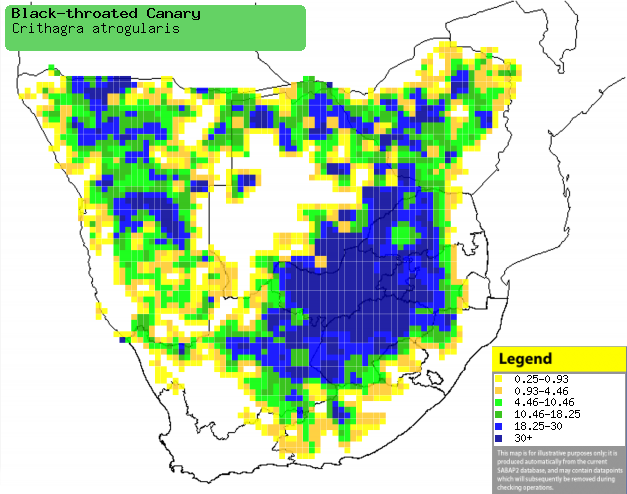|
Crithagra atrogularis
(Black-throated canary)
[= Serinus atrogularis]
Bergkanarie [Afrikaans]; Nsense, Kandingo (generic terms for
canaries) [Kwangali]; Toere (generic term for canaries and siskins) [South
Sotho]; Ngodzi [Tsonga]; Zwartkeelkanarie [Dutch]; Serin ą gorge noire
[French]; Angolagirlitz [German]; Canįrio-de-garganta-preta [Portuguese]
Life
> Eukaryotes >
Opisthokonta
> Metazoa (animals) >
Bilateria >
Deuterostomia > Chordata >
Craniata > Vertebrata (vertebrates) > Gnathostomata (jawed
vertebrates) > Teleostomi (teleost fish) > Osteichthyes (bony fish) > Class:
Sarcopterygii (lobe-finned
fish) > Stegocephalia (terrestrial
vertebrates) > Tetrapoda
(four-legged vertebrates) > Reptiliomorpha > Amniota >
Reptilia (reptiles) >
Romeriida > Diapsida > Archosauromorpha > Archosauria >
Dinosauria
(dinosaurs) > Saurischia > Theropoda (bipedal predatory dinosaurs) >
Coelurosauria > Maniraptora > Aves
(birds) >
Order: Passeriformes > Family: Fringillidae
Distribution and habitat
Occurs from Uganda through southern DRC, Angola and Zambia
to much of southern Africa excluding Mozambique, the Kalahari, fynbos biome and
the southern Karoo. It generally prefers open savanna, especially Acacia,
Burkea (Burkea africana) and miombo (Brachystegia) woodland, also
occupying dry riverine woodland, Nama karoo with grass, fallow croplands and
weedy road verges.
|
 |
|
Distribution of Black-throated longclaw in southern Africa,
based on statistical smoothing of the records from first SA Bird Atlas
Project (©
Animal Demography unit, University of
Cape Town; smoothing by Birgit Erni and Francesca Little). Colours range
from dark blue (most common) through to yellow (least common).
See here for the latest distribution
from the SABAP2. |
Movements and migrations
Mainly resident and sedentary, although it may
wander short distances in the dry season in search of water.
Food
It mainly eats, seeds, flowers, nectar and insects, doing
most of its foraging on the ground and in the foliage of shrubs, forbs and small
trees. The following food items have been recorded
in its diet:
- Plants
- seeds
- flowers
- nectar of Aloe greatheadii (Spotted aloe)
- Acacia gum
- Insects
-
aphids
- Hodotermes mossambicus (Northern harvester termite)
Breeding
- Usually a monogamous territorial solitary nester, although four birds were
once recorded building a single nest.
- The nest is built by both sexes in roughly six days, consisting of a cup
made of dry grass, petioles, Asparagus tendrils and fine twigs lined
with soft material, mainly plant down but also hair, wool and feathers. It
is typically placed in the upright fork of a tree branch, a bunch of pine
cones or the base of a palm frond.
- Egg-laying season is almost year-round, peaking from about
October-March.
- It lays 2-4 eggs, which are incubated solely by the female for about
12-15 days.
- The chicks are brooded solely by the female but fed by both parents,
leaving the nest after about 15-17 days.
Threats
Not threatened.
References
-
Hockey PAR, Dean WRJ and Ryan PG 2005. Roberts
- Birds of southern Africa, VIIth ed. The Trustees of the John Voelcker
Bird Book Fund, Cape Town.
|
